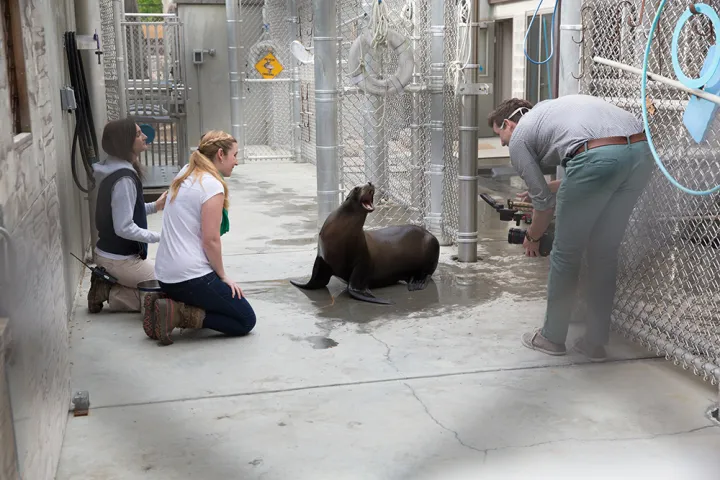How Do Sea Lions Swim?

A family of tourists in Canada’s Steveston Harbor recently got a treat when a friendly-looking sea lion sidled up to them in the water. The adorable animal came up to the edge of the wharf, and the family started feeding it. One young girl sat down to get a better look. That’s when the treat became a shock: the sea lion lunged upward and, in one fluid motion, grabbed a mouthful of the girl’s dress and yanked her down into the water.
The girl was fine—the sea lion quickly let go, and another man pulled her safely out of the water—but it was a good reminder that sea lions know how to maneuver their sizable bodies in water. Sea lions can be “bite-y,” acknowledges Megan Leftwich, a mechanical engineer at George Washington University. But she thinks the one in Steveston Harbor was just playing. “He didn’t actually bite her. He just pulled her in,” she says.
Leftwich studies sea lions from an unconventional perspective: fluid dynamics. Her expertise isn’t in sea lion behavior, but in how liquids like water flow and move around. As it turns out, much of how a sea lions navigates its watery environs can be gleaned by following what happens to the water around them.
If you watch the video of the sea lion pulling the girl into Steveston Harbor, you can see that the sea lion rises almost straight up out of the water, without swimming forward to pick up speed. In the same motion, it reaches past the rail of the wharf to grab a mouthful of the girl’s dress before falling back beneath the surface. It’s no wonder everyone was so surprised; the entire incident happened in an instant.
Leftwich says that sea lions generate thrust, or forward propulsion, by bringing their fore-flippers together in big sweeping motions called “claps.” But if you’re imagining flippers coming together with a loud smacking sound, think again. When a sea lion “claps,” it stretches its flippers out to the sides and sweeps them down. Then it tucks its flippers against its body, forming a torpedo shape that glides easily through the water.
The sea lion is the only aquatic mammal that swims this way. Most swimmers—from the tuna fish to the sea lion’s cousin, the seal—generate thrust with the back ends of their bodies, using their tails to propel themselves through water. But sea lions use their fore-flippers. What’s more, they’re very good at it. One clap generates enough thrust to let a sea lion glide through the water, leaving it free to twist or roll with very little additional movement.
Did the sea lion in Steveston Harbor clap with its flippers in order to lunge out of the water? Even after watching the video, it’s hard to know. “There’s just too much unknown to tell,” says Leftwich. “How deep the water is there, what the sea floor is (made of)”—these are just a few of the things she’d have to know in order to figure out how the sea lion is moving. But that doesn’t mean the video has nothing to teach us about sea lions; it’s no small feat to arc out of the water and successfully nab a human. “It does show how powerful and precise they are,” Leftwich says.
Another challenge for researchers is that the sea lion’s flippers are hidden from sight in the murky water. When you’re trying to figure out how a sea lion is moving, Leftwich says, the first step is to catch it on an underwater camera. That’s why she and her team of researchers have spent hours filming captive sea lions at Smithsonian’s National Zoo, trying to get clear video footage of the animals clapping so they can examine the way their flippers move from frame to frame. Two hours of filming usually yields about two or three minutes of useful footage.
After they capture a clap, Leftwich and her team mark the outline of the flipper in each frame so they can track its position in space over time. It takes six hours of work to track a single clap, but the effort pays off. Using the data from tracking, the researchers have created 3D diagrams of a sea lion flipper clapping. In them, you can see that a sea lion’s flipper twists as it claps.
Leftwich thinks that the twist might help cup the water in front of the sea lion and push it backwards so that the sea lion can shoot forwards, the same way a human does when swimming freestyle or breaststroke. To test her idea further, she and her team have built a robotic sea lion flipper. They plan to use it to replicate the motions of a real sea lion in a laboratory with a smaller tank, which will allow them to observe the water’s movement much more closely than they could in the big tank at the zoo.
Clapping and gliding, rolling and twisting, sea lions can be hard to follow with the eye, much less explain with science. Leftwich hasn’t yet figured out exactly how sea lions manipulate water with their flippers in order to move with such agility, but she’s getting closer. Figuring out this puzzle could be the secret to helping humans build stealthier autonomous submarines or other underwater vehicles, as WIRED magazine reported in 2015.
In the meantime, remember to keep a healthy distance from any sea lion you happen to see, or you might be in for an unwelcome surprise.
___
This article originally appeared on Smithsonian.com.



